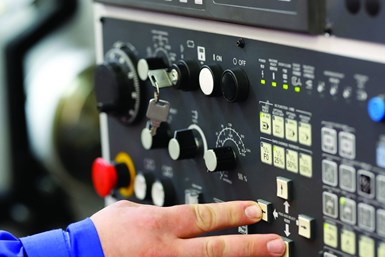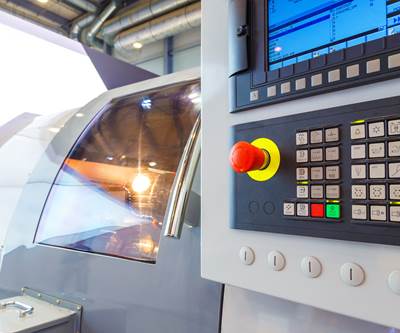How to Effectively Train CNC Machine Operators
A blended-learning approach uses external resources to teach the basics, saving in-house training for company-specific issues.
Share





Every manufacturing manager knows that finding and hiring experienced CNC machine operators in suitable numbers is nearly impossible. Consequently, companies are developing their own training methods to bring inexperienced people to a level at which they can be productive. My blended learning approach combines classroom instruction, on-the-job training and outside resources to address training needs.
If you want to minimize the amount of time your experienced people spend preparing and delivering curriculum, use outside resources to provide a foundation for training while reserving in-house classroom and on-the-job training for company-specific issues. External resources related to manufacturing and CNC include online classes, self-study materials, training consultants, machine builders and local schools. An appropriate combination can help your new employees achieve a common base. With this foundation in place, you can customize internal training sessions to fill any gaps, addressing any additional skills that are required. Let’s look at how this can be achieved with a few skills that all new CNC machine operators require.
Basic Machining Practices
The basic machining practices a CNC machine operator must master include shop safety, shop math, blueprint reading, tolerance interpretation and measuring devices. These topics are commonly considered prerequisite to CNC training.
External training resources typically begin with shop safety. There are many common dangers in machine shops, and external training can easily address them. But you probably know of several company-specific safety issues that must be addressed with your internal training. Consider, for instance, injuries that employees have suffered over the years. Develop curriculum for safety practices that, if followed, would have avoided them.
Shop math is one topic that external training may adequately address on its own. Your CNC machine operators must be able to repeatedly perform relatively simple arithmetic calculations without making any mistakes.
There are many resources that teach blueprint reading. While blueprint reading basics are universal for topics like orthographic projection, kinds of views and line types, design engineers vary dramatically with how they describe and dimension workpieces. Be ready to modify external blueprint reading classes and/or add internal curriculum to address variations. Pay special attention to how your design engineers annotate their drawings with title block information, revision specifications and common notes/callouts. Consider any special vocabulary/lingo used to reference workpiece attributes. If you use process drawings and/or special documentation to isolate workpiece attributes being machined in a given operation, they are unique to your company and must be explained during internal training sessions.
CNC machine operators must be able to take accurate measurements and determine whether measured attributes are within tolerance limits. When they are not, operators must know by how much to adjust CNC offsets.
Most external training providers provide generic training that shows how to use certain variable gages, like calipers and micrometers. It is likely that your company utilizes many more variable gage types than those covered by external training. You also may use certain fixed gages that are unique to your company. This means you must add internal instruction and hands-on practice for those gage types that have not been addressed during external training but that your workers must regularly use.
Eternal training will show how to interpret the three kinds of dimensional tolerances: 1) plus or minus a common value, 2) plus one value and minus another and 3) high/low limit specification. Your design engineers, however, probably focus on just one kind of dimensional tolerance specification. Limit tolerance interpretation exposure during external training to include only those kinds of tolerancing methods used in your company. Add internal curriculum to address any workpiece attributes that present uniquely troublesome measuring/adjustment issues.
CNC-Related Instruction
There are many external training sources that provide CNC-related instruction. However, almost every CNC feature can be used in a variety of ways. It is unlikely that all usage methods presented by external training courses will perfectly align with your company’s ways of doing things. This means that you will have to augment external training to include your company’s specific methods.
As a common example, consider program-zero assignment, which specifies the program origin location to the CNC machine. This, in effect, marries the workholding setup to the CNC program. Common techniques for assigning program zero include using spindle probes, dial indicators, edge finders and aligning bars. In addition, some companies utilize qualified workholding devices and have altogether eliminated the need for program-zero assignment, meaning an operator need not be involved.
While external training may include multiple ways of assigning program zero, your internal training and on-the-job practice must emphasize only those method(s) your company uses to assign program zero.
Similar variations exist with other CNC features like tool-length compensation and cutter-radius compensation on mills or wear offsets and tool-nose radius compensation on lathes. In every case, you must supplement external training that covers these topics with internal training that is specific to your company.
Related Content
Tips for Designing CNC Programs That Help Operators
The way a G-code program is formatted directly affects the productivity of the CNC people who use them. Design CNC programs that make CNC setup people and operators’ jobs easier.
Read MoreObscure CNC Features That Can Help (or Hurt) You
You cannot begin to take advantage of an available feature if you do not know it exists. Conversely, you will not know how to avoid CNC features that may be detrimental to your process.
Read More2 Secondary Coordinate Systems You Should Know
Coordinate systems tell a CNC machine where to position the cutting tool during the program’s execution for any purpose that requires the cutting tool to move.
Read More5 Reasons Why You Should Know How to Write Custom Macros
Custom macros enhance what can be done in G-code programs, giving users the ability to code operations that were previously not possible.
Read MoreRead Next
5 Things New CNC Machine Operators Must Know
These subjects are the building blocks of training newcomers on a specific CNC machine tool.
Read More5 Rules of Thumb for Buying CNC Machine Tools
Use these tips to carefully plan your machine tool purchases and to avoid regretting your decision later.
Read MoreSetting Up the Building Blocks for a Digital Factory
Woodward Inc. spent over a year developing an API to connect machines to its digital factory. Caron Engineering’s MiConnect has cut most of this process while also granting the shop greater access to machine information.
Read More
.jpg;width=70;height=70;mode=crop)




















.jpg;maxWidth=300;quality=90)









